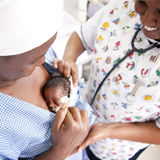
The National Neonatal Health Strategy 2004 had recommended for the development of guidelines for management of LBW babies at homes, communities and different levels of health services system. The group reviewed the available information regarding the magnitude of the problem of LBW babies, likely interventions feasible at homes and health facilities which would lower morbidities and mortality among LBW babies. The team members also visited various health institutions and project sites to gain first hand information of the management of LBW babies.
A baby born with a weight less than 2.5 kg at birth, irrespective of the gestational age, is termed a Low Birth Weight (LBW) baby. LBW, whether it is in a term or preterm infant, carries significant risks for neonatal morbidity and mortality. Globally, it is estimated that 40-80 % of neonatal deaths occur in LBW infants.
According to the hospital based data reported in State of the World’s Newborns: Nepal, 2001, deaths in LBW babies accounted for 66%, 75% and 84% of neonatal deaths in Patan Hospital, Maternity Hospital and TU Teaching Hospital respectively. Mortality rate was disproportionately very high among LBW babies.
Kangaroo Mother Care approach in the care and management of the Low Birth Weight babies was tried in a community setting at Kanchanpur district of Nepal. The analysis of the Kanchanpur Low Birth Weight Infants Care and Management program report (from Oct 2006 to September 2007) showed that the incidence of low birth weight was 16.7 % of the total 5865 babies delivered which is similar to National Demographic Survey 2006.
This implementation guideline addresses the major interventions for the management of Low Birth Weight babies. The interventions are BCC with an added focus on creation of awareness of the needs of LBW babies, care of LBW neonates, Prevention and management of hypothermia and recognition of LBW and VLBW with danger signs and their referral to health facilities.